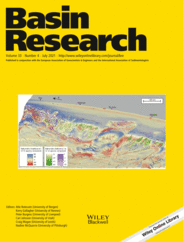
Full text loading...
 , Lidia Lonergan2, Xiufen Zhai1, Baomin Zhang1, Weihua Lu1
, Lidia Lonergan2, Xiufen Zhai1, Baomin Zhang1, Weihua Lu1
An intraplatform trough and associated platform margins formed in the Sichuan Basin, South China, during the Late Ediacaran to Early Cambrian. Seismic data show three stages of development of the trough. The first stage is characterized by considerable thinning of the lower two members of the Upper Ediacaran from the platform margins to the trough. In the second stage, in the late Late Ediacaran, the platform margins backstepped and the extent of the trough expanded significantly. The third stage, in the early Early Cambrian, was dominated by gradual filling of the trough and onlapping of the platform margins. Integrating with tectonic subsidence analysis, we infer that the trough was a palaeogeographic embayment in a large carbonate platform.
The Upper Ediacaran to Lower Cambrian of the Sichuan Basin in South China has long been considered to be dominated by shallow‐water deposition. Hydrocarbon exploration, however, has revealed that a NW‐SE trending intraplatform trough formed in the basin during the same period. Although different models have been proposed, the formation and evolution of the trough are still not fully understood. In this study, we investigate both the origin of the intraplatform trough and the formation of the Sichuan Basin by integrating seismic interpretation, well correlation and tectonic subsidence analysis. The seismic and well data clearly show three stages of development of the trough. The first stage, in the early Late Ediacaran, is characterized by considerable thinning of the lower two members of the Upper Ediacaran from the platform margins to the trough. In the second stage, in the late Late Ediacaran, the platform margins backstepped and the extent of the trough expanded significantly to a width of ca. ~400 km. The third stage, in the early Early Cambrian, was dominated by gradual filling of the trough and onlapping of the platform margins. Backstripped tectonic subsidence curves show one, or two closely spaced episodes of linear subsidence starting at ~550 Ma and then decreasing exponentially until ~450 Ma. The shape of the subsidence curves is consistent with formation of the Sichuan Basin by low, and slow amounts of lithospheric stretching of thickened cratonic lithosphere. The tectonic subsidence increases from the centre to the NW of the basin. Interestingly the margins of the trough do not correlate with contoured values of increased tectonic subsidence and we infer that the trough was a palaeogeographic embayment in a large carbonate platform that developed in a broad, ramp‐like area of slow and low subsidence tilting down to the proto‐Tethyan ocean located to the NW of the basin.
]
Article metrics loading...

Full text loading...
References


Data & Media loading...

